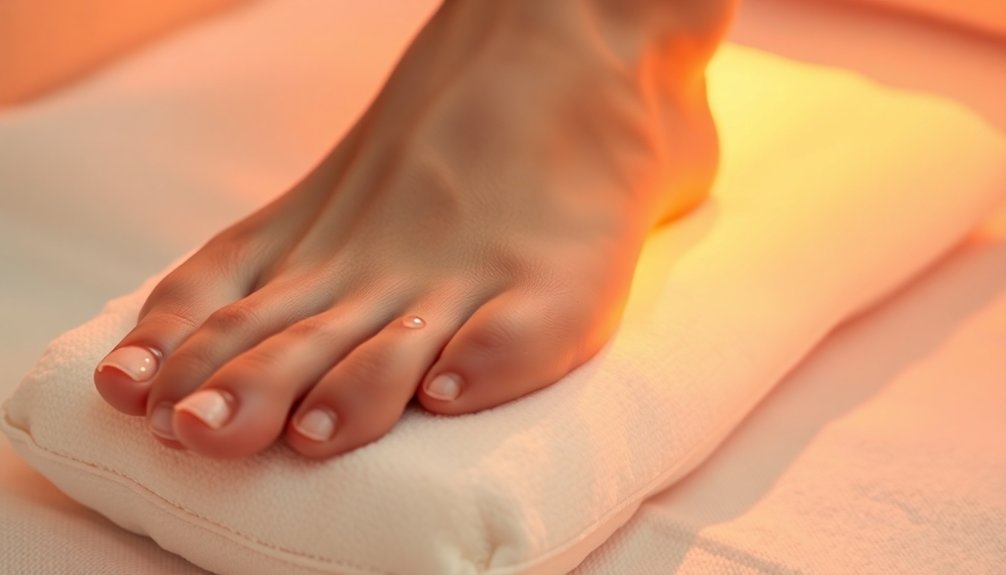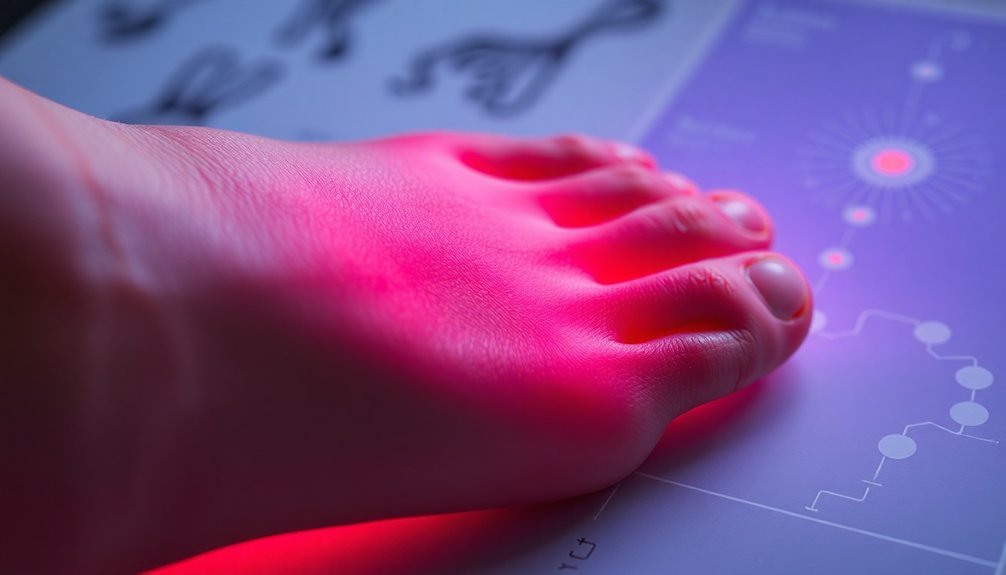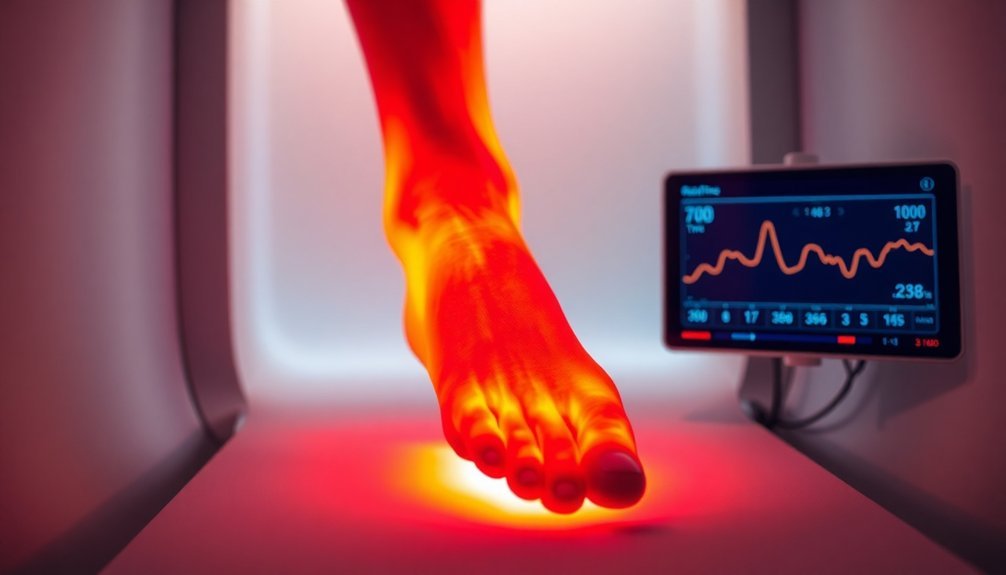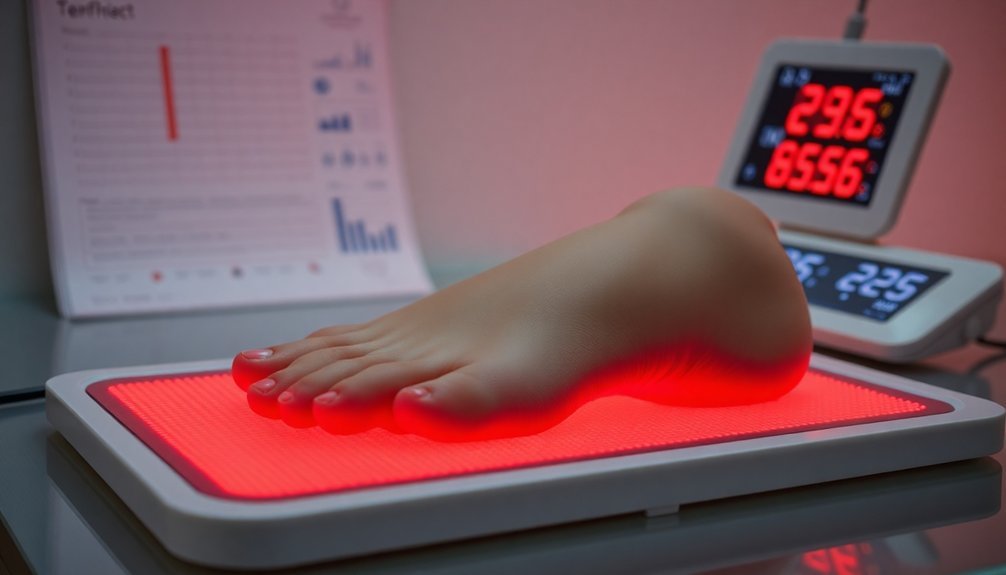Infrared therapy offers five smart ways to boost your foot health if you're diabetic. First, it accelerates wound healing by increasing tissue regeneration and reducing inflammation. Second, it improves circulation, ensuring your feet stay warm and preventing complications. Third, it reduces pain and inflammation, providing natural relief from neuropathy. Fourth, infrared helps prevent foot ulcers through early detection and monitoring of temperature differences. Finally, it enhances overall monitoring, allowing for quick diagnosis and continuous health checks. If you're curious about how these methods can make a difference in your life, there's more to discover.
Accelerates Wound Healing

When it comes to accelerating wound healing, infrared therapy really steps up to the plate. This treatment boosts tissue regeneration by increasing the formation of new capillaries, which enhances the healing process. In studies, you'd notice a significant rise in neo-vessels among those receiving infrared therapy compared to control groups.
It also stimulates fibroblast production, vital for synthesizing collagen, elastin, and proteoglycans necessary for closing wounds. Moreover, infrared therapy reduces inflammation and exudation, creating a more favorable environment for healing. You can expect lower levels of pro-inflammatory responses and improved phagocytosis, which helps eliminate dead cells and bacteria. Enhanced lymphatic activity guarantees your wound stays clean and detoxified.
You'll also appreciate how infrared therapy promotes robust granulation tissue formation, which is essential for healing. Infrared-treated wounds display a vibrant, beefy red granulation tissue, signaling healthy growth and correlating with faster healing times. Additionally, this therapy, as shown in a recent study on IRE, can lead to significant healing improvements in chronic wounds, demonstrating its potential over conventional treatments.
Improves Blood Circulation
Infrared therapy plays an essential role in enhancing blood circulation, which is especially beneficial for individuals with diabetic feet. By utilizing far-infrared radiation (FIR), this therapy improves vessel dilation and boosts blood flow, particularly to key areas like the dorsalis pedis artery and the plantar foot.
You'll notice a significant increase in foot temperature—up by 2° after treatment—indicating enhanced circulation and improved overall foot health. Studies indicate that elevated blood glucose levels can lead to serious complications, making improved circulation vital for preventing diabetic foot ulcers.
FIR therapy not only raises surface temperature but also improves autonomic nervous system regulation. This balance helps maintain circulation, reducing the risk of complications such as diabetic foot ulcers.
Better autonomic function promotes elevated foot perfusion, important for your foot's well-being.
Moreover, as you experience improved circulation, you'll likely find relief from sensations of soreness, tingling, and coldness. Tools like the Edinburgh Claudication Questionnaire show that you might see significant reductions in these symptoms, enhancing your overall foot health.
FIR therapy isn't just about comfort; it plays a critical role in preventing serious issues related to poor circulation, thereby promoting a healthier, more active lifestyle.
Reduces Pain and Inflammation

Improved blood circulation leads to another notable benefit of infrared therapy: it effectively reduces pain and inflammation associated with diabetic feet. This non-invasive treatment stimulates endorphin production, providing natural pain relief for those struggling with diabetic neuropathy. In fact, studies show a remarkable 67% reduction in pain levels after just ten treatment sessions. You might also appreciate that pulsed infrared light therapy improves peripheral sensation, which further aids in alleviating discomfort. Additionally, infrared therapy plays a crucial role in healing damaged nerves, as it enhances blood circulation to the affected areas.
When it comes to inflammation, infrared therapy promotes the release of nitric oxide, enhancing healing while reducing swelling. This therapy delivers oxygen and nutrients to damaged nerves, facilitating recovery. Here's a quick overview of how infrared therapy can help:
| Benefit | Impact | Research Findings |
|---|---|---|
| Pain Reduction | Alleviates discomfort | 67% reduction in pain |
| Inflammatory Response | Reduces swelling | Lowers inflammation |
| Peripheral Sensation Improvement | Enhances feeling in feet | Increases sensitivity |
| Safety | Few side effects | Well-tolerated compared to medications |
| Healing Support | Accelerates recovery | Promotes tissue repair |
Using infrared therapy can notably enhance your comfort and overall health.
Prevents Foot Ulcers
Diabetic foot ulcers can lead to severe complications, but effective preventive measures are now more accessible. By using infrared temperature monitoring, you can catch potential issues early on. If you notice a temperature difference greater than 4°F between areas on your feet, it's a sign to reduce activity and take action.
Patients who used infrared skin thermometers experienced a significant decrease in foot ulcers, with only 8.5% developing them compared to 29.3% in standard therapy groups.
Additionally, smart technology, like insoles with pressure sensors, sends alerts to your smartwatch. These reminders help guarantee you wear your orthopedic footwear, which dramatically reduces ulcer risk. If you receive alerts at least every two hours, you're more likely to stay compliant.
Thermographic imaging also aids in early diagnosis by detecting temperature variability in different areas of your feet, prompting timely intervention.
Adhering to these infrared monitoring practices can reduce your likelihood of developing ulcers substantially. By staying aware and responsive to the technology, you can take smart steps toward protecting your diabetic feet and preventing ulcer formation effectively.
Enhances Monitoring and Detection

When it comes to foot care, monitoring and detection are vital for avoiding serious complications. Using infrared technology, you can spot issues early, which is important since untreated complications can lead to severe outcomes.
| Benefit | Detail | Importance |
|---|---|---|
| Early Detection | Infrared thermography identifies temperature differences. | Helps prevent local and diffuse complications. |
| Diagnostic Accuracy | Smartphone IR cameras have high sensitivity and specificity. | Guarantees accurate assessments of foot health. |
| Home Monitoring | Handheld thermometers let you check foot temperatures. | Allows for early signs of inflammation detection. |
| Automated Detection | Algorithms analyze data for faster diagnosis. | Saves time and reduces manual analysis. |
| Integration with Telemedicine | Combines infrared imaging with remote care. | Enhances continuous monitoring of foot issues. |
Frequently Asked Questions
How Long Does an Infrared Therapy Session Typically Last?
An infrared therapy session typically lasts between 15 to 30 minutes. You may find shorter sessions of 10 minutes in some cases. Consistency's important, so aim for multiple sessions each week for best results.
Are There Any Age Restrictions for Using Infrared Therapy?
Yes, there are age considerations. Minors need parental consent and supervision. For adults, there's no maximum age, but if you have medical conditions, it's best to consult a healthcare provider before using infrared therapy.
Can Infrared Therapy Be Used Alongside Diabetes Medications?
Yes, you can use infrared therapy alongside diabetes medications. It's essential to monitor your overall health and consult your healthcare provider to adjust treatments as necessary, ensuring safe integration of both therapies for best benefits.
How Often Should Infrared Therapy Be Administered for Best Results?
For best results, you should aim for weekly infrared therapy sessions lasting 15 minutes each. This schedule can help optimize your treatment outcomes, adjusting as needed based on your specific health conditions and responses.
Is Infrared Therapy Suitable for All Types of Diabetic Foot Conditions?
Infrared therapy isn't suitable for all diabetic foot conditions. It's effective for grade 1 and 2 ulcers but hasn't shown benefits for higher grades. Always consult your healthcare provider for personalized recommendations based on your specific situation.
In Summary
Infrared therapy offers a powerful approach to managing diabetic foot complications. By accelerating wound healing, improving blood circulation, reducing pain and inflammation, preventing foot ulcers, and enhancing monitoring, it's a smart choice for keeping your feet healthy. Embracing this technology not only promotes better foot health but also enhances your overall quality of life. Take charge of your well-being and consider integrating infrared therapy into your routine—you'll be glad you did!





Leave a Reply